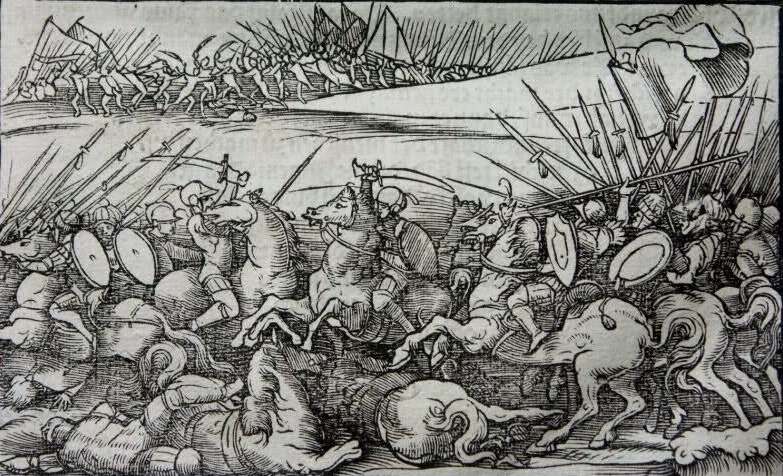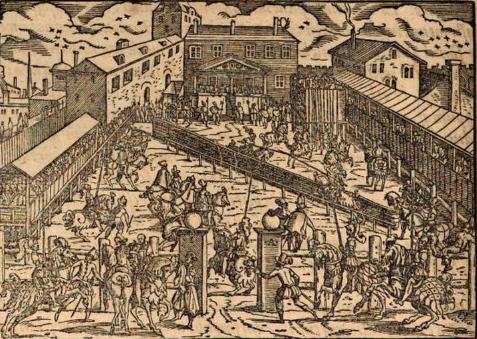|
Tetovë
Tetovo ( mk, Тетово, , sq, Tetovë/Tetova) is a city in the northwestern part of North Macedonia, built on the foothills of Šar Mountain and divided by the Pena River. The municipality of Tetovo covers an area of at above sea level, with a population of 52,915. The city of Tetovo is the seat of Tetovo Municipality. Tetovo was founded in the 14th century on the place of the ancient town of Oaeneon. In the 15th c. AD, Tetovo came under Ottoman rule for about five centuries. For a short period of time during the 15th century, Tetovo came under the control of the Albanian state, League of Lezhë led by Gjergj Kastrioti Skanderbeg and the Albanians achieved a victory over the Ottomans in the Battle of Polog. After its conquest by the Ottomans, most of city's population converted to Islam and many Ottoman-style structures were built, such as the Šarena Džamija and the Arabati Baba Teḱe, which still stand as two of Macedonia's most significant landmarks of its Ottoman p ... [...More Info...] [...Related Items...] OR: [Wikipedia] [Google] [Baidu] |
Albanians In North Macedonia
The Albanians in North Macedonia ( sq, Shqiptarët në Maqedoninë e Veriut, mk, Албанци во Северна Македонија) are the second largest ethnic group in North Macedonia, forming 446,245 individuals or 24.3% of the resident population. Of the 2,097,319 total population in the 2021 census (including self-enumerated diaspora), 619,187 or 29.52% are Albanians. Geography The Albanian minority is concentrated mostly in the western, north-western and partially middle area of the country with small communities located in the south-west. The largest Albanian communities are in the municipalities of Tetovo (71.3% of the total population), Gostivar (55.3%), Debar (54.8%), Struga (50.6%), Kičevo (41.3%), Kumanovo (26.0%), and Skopje (22.9%). Toponymy A number of placenames in North Macedonia have been considered as being ultimately derived through Albanian. Some cases include: *Štip (''Shtip'' in Albanian) is a city in eastern North Macedonia. It was known i ... [...More Info...] [...Related Items...] OR: [Wikipedia] [Google] [Baidu] |
State University Of Tetovo
The State University of Tetova ( sq, Universiteti Shtetëror i Tetovës; mk, Државен Универзитет во Тетово) is a public university in North Macedonia. The university was established on 17 December 1994 as the first Albanian language higher education institution in Macedonia, though not recognized as a state university by the national government until January 2004. Courses and lectures are held in Albanian, Macedonian and English. As of 2018–19 school year, a total of 7,097 students are enrolled at the university. History The State University of Tetova was founded on 17 December 1994 upon the initiative of the Albanian Cultural Society of North Macedonia. The first lectures were held on February 16–17, 1995 in Poroj and Rečica. Faculties and departments The university consists of eleven faculties: * Faculty of Economics * Faculty of Law * Faculty of Applied Sciences * Faculty of Fine Arts * Faculty of Philosophy * Faculty of Philology * Faculty of ... [...More Info...] [...Related Items...] OR: [Wikipedia] [Google] [Baidu] |
Tetovo Municipality
Tetovo ( mk, Тетово, ; sq, Tetovë) is a municipality in the northwest part of North Macedonia. Tetovo is also the name of the town where the municipal seat is found. Tetovo Municipality is part of the Polog Statistical Region. Geography The municipality borders Kosovo to the north and west, Tearce Municipality to the northeast, Jegunovce Municipality to the east, Želino Municipality to the southeast, Brvenica Municipality to the south, and Bogovinje Municipality Bogovinje ( mk, , sq, Komuna e Bogovinës) is a municipality in the western part of the Republic of North Macedonia. Bogovinje is also the name of the village where the municipal seat is found. Bogovinje Municipality is part of the Polog Sta ... to the southwest. History As a result of the redrawing of municipality borders in 2003, the rural Šipkovica Municipality and Džepčište Municipality were attached to Tetovo Municipality. Without these two municipalities, the population of the Municipality ... [...More Info...] [...Related Items...] OR: [Wikipedia] [Google] [Baidu] |
List Of Cities In North Macedonia
This is a list of cities and towns in North Macedonia. There are 34 cities and towns in North Macedonia. In Macedonian, every city or town, regardless of size, is called ''grad'' (''град'', pl. ''gradovi'', ''градови''), but a smaller one can also be called ''gratče'' (''гратче'', pl. ''гратчиња'', ''gratčinja''), a diminutive of ''grad''. Only five cities in the country have a population of more than 50,000 inhabitants. The capital, Skopje, is home to about 25% of the country's total population. The 2002 census showed that the majority of the population, 59.5%, lived in urban areas. The five largest cities in North Macedonia, each with a population of over 50,000 inhabitants, are: Skopje (506,926), Bitola (74,550), Kumanovo (70,842), Prilep (66,246) and Tetovo (52,915). Seventeen cities in the country have a population between 10,000 and 50,000 inhabitants: Veles (43,716), Štip (43,652), Ohrid (42,033), Gostivar (35,847), Strumica (35,311), Kavadarci ... [...More Info...] [...Related Items...] OR: [Wikipedia] [Google] [Baidu] |
Oceanic Climate
An oceanic climate, also known as a marine climate, is the humid temperate climate sub-type in Köppen classification ''Cfb'', typical of west coasts in higher middle latitudes of continents, generally featuring cool summers and mild winters (for their latitude), with a relatively narrow annual temperature range and few extremes of temperature. Oceanic climates can be found in both hemispheres generally between 45 and 63 latitude, most notably in northwestern Europe, northwestern America, as well as New Zealand. Precipitation Locations with oceanic climates tend to feature frequent cloudy conditions with precipitation, low hanging clouds, and frequent fronts and storms. Thunderstorms are normally few, since strong daytime heating and hot and cold air masses meet infrequently in the region. In most areas with an oceanic climate, precipitation comes in the form of rain for the majority of the year. However, some areas with this climate see some snowfall annually during winter. ... [...More Info...] [...Related Items...] OR: [Wikipedia] [Google] [Baidu] |
Ancient Greek
Ancient Greek includes the forms of the Greek language used in ancient Greece and the ancient world from around 1500 BC to 300 BC. It is often roughly divided into the following periods: Mycenaean Greek (), Dark Ages (), the Archaic period (), and the Classical period (). Ancient Greek was the language of Homer and of fifth-century Athenian historians, playwrights, and philosophers. It has contributed many words to English vocabulary and has been a standard subject of study in educational institutions of the Western world since the Renaissance. This article primarily contains information about the Epic and Classical periods of the language. From the Hellenistic period (), Ancient Greek was followed by Koine Greek, which is regarded as a separate historical stage, although its earliest form closely resembles Attic Greek and its latest form approaches Medieval Greek. There were several regional dialects of Ancient Greek, of which Attic Greek developed into Koi ... [...More Info...] [...Related Items...] OR: [Wikipedia] [Google] [Baidu] |
South East European University
South East European University (SEEU) is an internationally recognized private-public nonprofit higher education institution officially inaugurated in 2001 upon initiative of former top-level Dutch diplomat and OSCE High Commissioner on National Minorities HE Max van der Stoel and is located in Tetovo, North Macedonia with a branch campus in Skopje. Since its establishment the university has succeeded in combining the best of European and U.S. experience and has continued to benefit from countless academic collaborations sponsored by the European Commission and USAID, among other donors. During the opening ceremony former Swedish diplomat HE Rolf Ekéus stated: ''"Today is a good day for Europe. At a time when good news is in short supply, it is heartening to see that progress can be made towards building peace among people. ��In the future, people will think of Tetovo as the site of a enownedmulti-lingual university".'' The university is an associate member of the E ... [...More Info...] [...Related Items...] OR: [Wikipedia] [Google] [Baidu] |
Struga
Struga ( mk, Струга , sq, Strugë) is a town and popular tourist destination situated in the south-western region of North Macedonia, lying on the shore of Lake Ohrid. The town of Struga is the seat of Struga Municipality. Name The name Struga was first mentioned in the 11th century. It is of Slavic origin. and means a "river bed". The ancient name of the city is Enchalon (Εγχαλών), the ancient Greek word for eel, which may be related to the Illyrian Enchele tribe that was known to live in the region. According to E. Hamp, a connection with Albanian ’ngjalë’ makes it possible that the name Enchele was derived from the Illyrian term for eels, which may have been anciently related to Greek and simply adjusted to the Greek pronunciation. In Polybius the word 'Enchele' is written with a voiceless aspirate ''kh'', ''Enchelanes'', while in Mnaseas it was replaced with a voiced ''ng'', ''Engelanes'', the latter being a typical feature of the Ancient Macedon ... [...More Info...] [...Related Items...] OR: [Wikipedia] [Google] [Baidu] |
Battle Of Polog
The Battle of Polog was the result of an Albanian incursion into Ottoman territory. Aided by Alfonso the Magnanimous, the Albanian leader Skanderbeg made plans to recapture Svetigrad, which had been lost in 1448. His strategy involved launching an invasion of Macedonia to devastate the country surrounding Svetigrad and to lure the garrison into a trap. While implementing this, he was stopped in the fields of Polog near Tetovo by a force which was planning to invade Albania led by his old friend Ibrahim Pasha. The force was quickly destroyed and Skanderbeg's army proceeded its looting before returning to Debar. Background Skanderbeg lost Svetigrad in 1448 after a two-month-long siege. The fortress was vital to his strategic defense of Albania as it guarded one of the main mountain passes into the country from Macedonia. He, therefore, made efforts to regain it with the help of Alfonso V of Aragon; in the Treaty of Gaeta signed in 1451, Skanderbeg became a vassal of Alfonso in re ... [...More Info...] [...Related Items...] OR: [Wikipedia] [Google] [Baidu] |
Albanians
The Albanians (; sq, Shqiptarët ) are an ethnic group An ethnic group or an ethnicity is a grouping of people who identify with each other on the basis of shared attributes that distinguish them from other groups. Those attributes can include common sets of traditions, ancestry, language, history, ... and nation native to the Balkan Peninsula who share a common Albanian Cultural heritage, ancestry, Albanian culture, culture, Albanian history, history and Albanian language, language. They primarily live in Albania, Kosovo, North Macedonia, Montenegro, Serbia as well as in Croatia, Greece, Italy and Turkey. They also constitute a large diaspora with several communities established across Europe, the Americas and Oceania. Albanians have Paleo-Balkan languages, Paleo-Balkanic Origin of the Albanians, origins. Exclusively attributing these origins to the Illyrians, Thracians or other Paleo-Balkan people is still a matter of debate among historians and ethnologists. The firs ... [...More Info...] [...Related Items...] OR: [Wikipedia] [Google] [Baidu] |
Skanderbeg
, reign = 28 November 1443 – 17 January 1468 , predecessor = Gjon Kastrioti , successor = Gjon Kastrioti II , spouse = Donika Arianiti , issue = Gjon Kastrioti II , royal house = Kastrioti , father = Gjon Kastrioti , mother = Voisava Kastrioti , birth_name = Gjergj ( see Name) , birth_date = 1405 , birth_place = Principality of Kastrioti , death_date = 17 January 1468 (aged 62) , death_place = Alessio, Republic of Venice , place of burial = Church of Saint Nicholas, Lezhë , religion = Islam Catholicism , occupation = Lord of the Principality of Kastrioti, , signature = Dorëshkrimi i Skënderbeut.svg Gjergj Kastrioti ( la, Georgius Castriota; it, Giorgio Castriota; 1405 – 17 January 1468), commonly known as Skanderbeg ( sq, Skënderbeu or ''Skënderbej'', from ota, اسکندر بگ, İskender Bey; it, Scanderbeg), was an Albanian feudal lord and military commander who led a rebellion agai ... [...More Info...] [...Related Items...] OR: [Wikipedia] [Google] [Baidu] |
.png)

